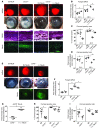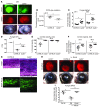Fungal antioxidant pathways promote survival against neutrophils during infection
- PMID: 22706306
- PMCID: PMC3534057
- DOI: 10.1172/JCI63239
Fungal antioxidant pathways promote survival against neutrophils during infection
Abstract
Filamentous fungi are a common cause of blindness and visual impairment worldwide. Using both murine model systems and in vitro human neutrophils, we found that NADPH oxidase produced by neutrophils was essential to control the growth of Aspergillus and Fusarium fungi in the cornea. We demonstrated that neutrophil oxidant production and antifungal activity are dependent on CD18, but not on the β-glucan receptor dectin-1. We used mutant A. fumigatus strains to show that the reactive oxygen species-sensing transcription factor Yap1, superoxide dismutases, and the Yap1-regulated thioredoxin antioxidant pathway are each required for protection against neutrophil-mediated oxidation of hyphae as well as optimal survival of fungal hyphae in vivo. We also demonstrated that thioredoxin inhibition using the anticancer drug PX-12 increased the sensitivity of fungal hyphae to both H2O2- and neutrophil-mediated killing in vitro. Additionally, topical application of PX-12 significantly enhanced neutrophil-mediated fungal killing in infected mouse corneas. Cumulatively, our data reveal critical host oxidative and fungal anti-oxidative mediators that regulate hyphal survival during infection. Further, these findings also indicate that targeting fungal anti-oxidative defenses via PX-12 may represent an efficacious strategy for treating fungal infections.
Figures










Similar articles
-
Targeting iron acquisition blocks infection with the fungal pathogens Aspergillus fumigatus and Fusarium oxysporum.PLoS Pathog. 2013;9(7):e1003436. doi: 10.1371/journal.ppat.1003436. Epub 2013 Jul 11. PLoS Pathog. 2013. PMID: 23853581 Free PMC article.
-
Class IA phosphoinositide 3-kinase β and δ regulate neutrophil oxidase activation in response to Aspergillus fumigatus hyphae.J Immunol. 2011 Mar 1;186(5):2978-89. doi: 10.4049/jimmunol.1002268. Epub 2011 Jan 21. J Immunol. 2011. PMID: 21257963
-
Aspergillus and Fusarium corneal infections are regulated by Th17 cells and IL-17-producing neutrophils.J Immunol. 2014 Apr 1;192(7):3319-27. doi: 10.4049/jimmunol.1302235. Epub 2014 Mar 3. J Immunol. 2014. PMID: 24591369 Free PMC article.
-
Immunity to pathogenic fungi in the eye.Semin Immunol. 2023 May;67:101753. doi: 10.1016/j.smim.2023.101753. Epub 2023 Apr 13. Semin Immunol. 2023. PMID: 37060806 Free PMC article. Review.
-
Transcriptomic insights into the oxidative response of stress-exposed Aspergillus fumigatus.Curr Pharm Des. 2013;19(20):3713-37. doi: 10.2174/1381612811319200011. Curr Pharm Des. 2013. PMID: 23278536 Review.
Cited by
-
Monocyte- and macrophage-targeted NADPH oxidase mediates antifungal host defense and regulation of acute inflammation in mice.J Immunol. 2013 Apr 15;190(8):4175-84. doi: 10.4049/jimmunol.1202800. Epub 2013 Mar 15. J Immunol. 2013. PMID: 23509361 Free PMC article.
-
Fatal disseminated fusarium infection in a human immunodeficiency virus positive patient.Case Rep Infect Dis. 2013;2013:379320. doi: 10.1155/2013/379320. Epub 2013 May 13. Case Rep Infect Dis. 2013. PMID: 23762675 Free PMC article.
-
Transcriptional Control of Drug Resistance, Virulence and Immune System Evasion in Pathogenic Fungi: A Cross-Species Comparison.Front Cell Infect Microbiol. 2016 Oct 20;6:131. doi: 10.3389/fcimb.2016.00131. eCollection 2016. Front Cell Infect Microbiol. 2016. PMID: 27812511 Free PMC article. Review.
-
Stress-Tolerant Yeasts: Opportunistic Pathogenicity Versus Biocontrol Potential.Genes (Basel). 2019 Jan 14;10(1):42. doi: 10.3390/genes10010042. Genes (Basel). 2019. PMID: 30646593 Free PMC article.
-
Aspergillus Endophthalmitis: Epidemiology, Pathobiology, and Current Treatments.J Fungi (Basel). 2022 Jun 22;8(7):656. doi: 10.3390/jof8070656. J Fungi (Basel). 2022. PMID: 35887412 Free PMC article. Review.
References
-
- Liesegang TJ, Forster RK. Spectrum of microbial keratitis in South Florida. Am J Ophthalmol. 1980;90(1):38–47. - PubMed
Publication types
MeSH terms
Substances
Grants and funding
LinkOut - more resources
Full Text Sources
Other Literature Sources
Medical

